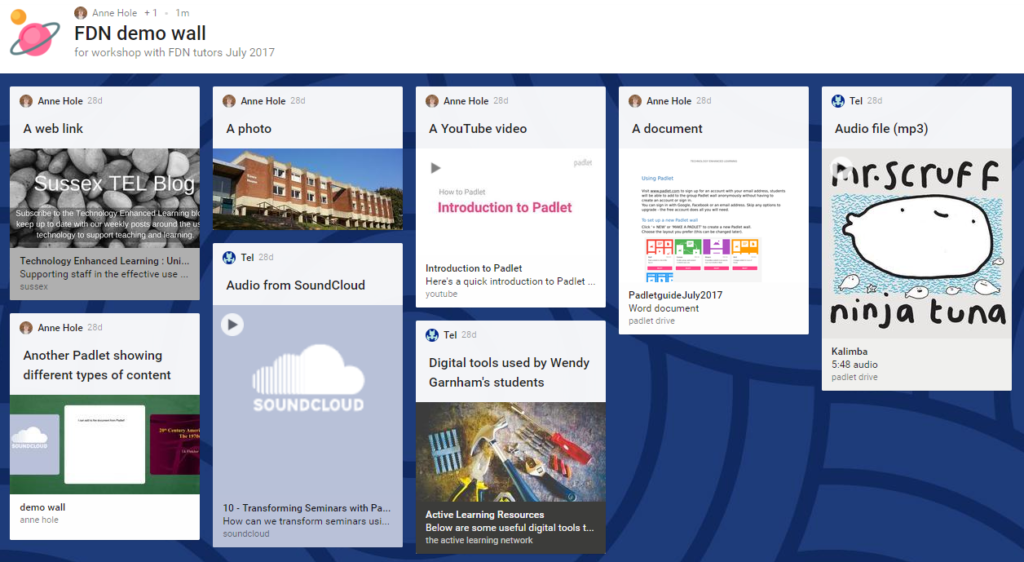Over the last couple of years we have often mentioned Padlet in our blog posts* and workshops but never devoted a whole blog post to this versatile tool. As there have been some useful updates recently this seems like a good time to have a closer look at Padlet and how it can be used in teaching and learning.
What is Padlet?
Padlet provides a free virtual wall where users can post content and comments. Most types of digital content can be added to a Padlet (directly or as a web link) and the options for layout, access and permissions make it useful in a wide range of settings.

An example of a Padlet showing some of the content that can be posted. Click on the image to see it on Padlet.
How are people using Padlet?
Many staff at the University of Sussex are using Padlet for collaborative work and learning. Two of the first projects using Padlet at the University were outlined in this post on the #altc blog by Professor Lucy Robinson (History) and Dr Rebecca Webb (Education) which show how versatile it can be. Where Lucy and her students were using Padlet to create learning resources, Rebecca’s students used it as a social and reflective space.
More recently, Dr Wendy Garnham’s Foundation Year Psychology students have been creating a rich mix of digital artefacts during seminars and sharing them to group Padlet walls for others to comment on. Wendy and some of the students presented their use of Padlet at the Sussex Teaching and Learning Conference 2017 and you can hear Wendy talk about Transforming Seminars with Padlet for the Teaching with Tech Podcast.
Padlet can also be great for gathering ideas and comments in meetings or at events. Recently we used Padlet walls as sharing spaces during some of the Take 5 online courses, so that participants could share in a more visual way than through a forum. We set the sharing and commenting options so that everyone on the course could post and comment, and embedded the Padlet wall into the Study Direct (VLE) site so that it could be seen and added to without leaving the site.
How can I get started with Padlet?
This short video will introduce Padlet and show you some of the options.
Then this short step-by-step guide will take you through the steps to setting up a wall (also available as a PDF Padlet Guide).
1. Visit www.padlet.com to sign up for a free account.
2. Click ‘+ NEW’ or ‘MAKE A PADLET’ to create a new Padlet wall and choose the layout you prefer (this can be changed later by going to the … menu). The options are:
or there are ready-made templates for many different purposes (moodboard, Q&A, Video playlist, storyboard etc.)
3. Once your wall is created you will be prompted to ‘Modify’ the title and description; choose the wallpaper background, allow attribution and commenting (or not) and choose your own URL.
4. Click NEXT to move onto People and Privacy settings. These will determine how visible your wall is. You can also adjust the editing rights of your wall here. The privacy options are:
- Private – Only you and the people you add as contributors can access the padlet.
- Password protected – Visitors will need to enter a password (of your choosing) in order to access the padlet.
- Secret – Anyone who has the link or QR code can access the padlet. It will not be visible in Google search or public areas of Padlet.
- Public – Anyone can access the padlet. It will appear in internal search as well as Google, and may be featured by Padlet on community pages.
If you are using Padlet with students you probably want to make it Secret and share the URL with them. For a smaller group you can add individual collaborators via email.
5. You are now ready to start posting! Double click on any empty space or the big pink + icon. A box like this will appear: 6. Give your post a title then click on the icons to add audio, video, a web link, photo or document. Posts can be edited after posting if required.
6. Give your post a title then click on the icons to add audio, video, a web link, photo or document. Posts can be edited after posting if required.
For more information, have a look at the Padlet ‘Getting Started’ resources and FAQs.
Staff at the University of Sussex who are interested in using Padlet can discuss the options that might be best for them and their students and get one-to-one support from tel@sussex.ac.uk.
*Padlet has been mentioned in these previous blog posts:
- Working together online
- Get connected – engaging with online communities
- Get creative! Smartphones for learning
- Learning together: Technology enhanced collaboration.
- 3 ways to develop rich resources on Study Direct (Moodle)
- 5 Tips for Multimedia Enhanced Teaching and Learning
- How to overcome barriers when using tech in your teaching



Interesting to see that so many staff at the university are using Padlet. I’m also a fan.
I wondered if you know if I can see how many visitors have visited my Padlet page.
I have shared a presentation and links with students from my classes and I want to know how many have gone to the Padlet page after the class to look or download materials. Is there a function for this?
Thanks!
Hi Rob. Thank you for commenting. Most of our users are asking students to post to a board, so it is possible to see who has done the task.
Padlet support at http://jn.padlet.com/ might have an answer for you.
Now that Padlet is no longer free, does the University have an account we can all use?
Yes. You can read about it and how to sign up at http://blogs.sussex.ac.uk/tel/2018/09/04/padlet-backpack-now-available-at-sussex/